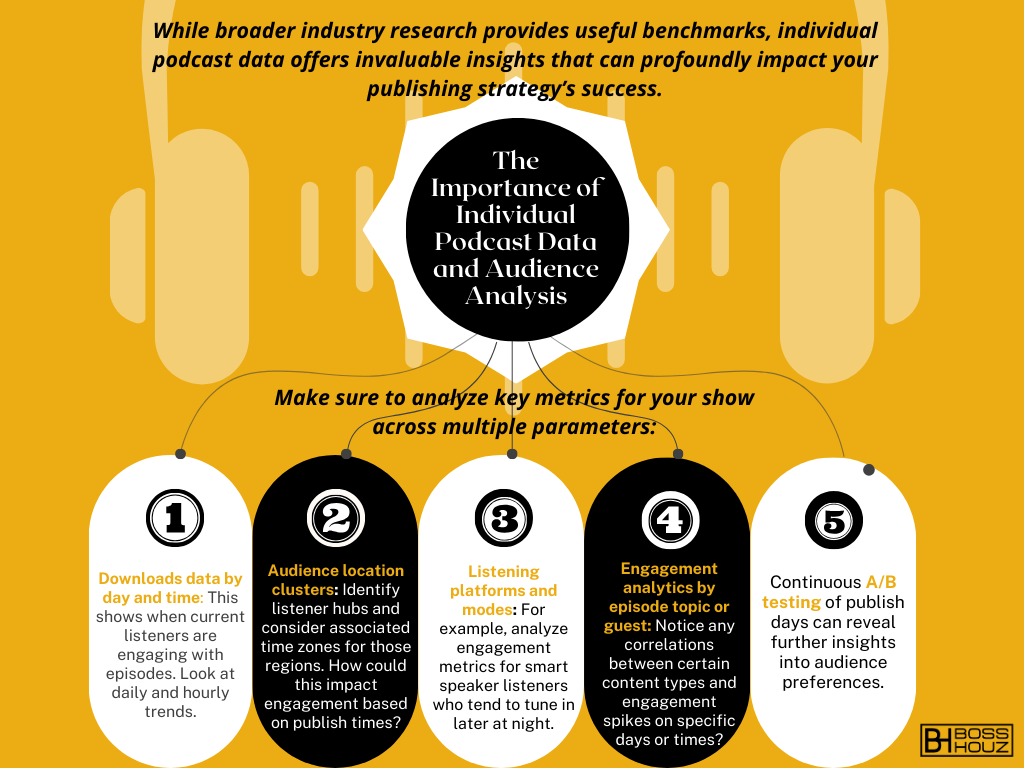The Science (or Lack Thereof) Behind the “Best Day” Myth
Contrary to popular belief, there is no clear scientific consensus on the “best day” to publish your podcast episodes if we analyze global averages alone. Many websites will confidently declare that Tuesday or Wednesday is objectively the best day for maximizing downloads. However, relying solely on broad averages ignores the importance of individual podcast data and audience demographics.
Before deciding on the perfect release day, you need to dig deeper and debunk some common assumptions that form the basis of the “best day” myth:
- Global averages smooth over significant differences across genres, listener demographics, and individual podcasts. A Tuesday release may work well for some comedy podcasts but not for a niche B2B show.
- Most analysis overlooks the impact of time zones and geographical differences across a global listener base. What’s the ideal Tuesday for audiences in Australia vs. the UK vs. North America?
- Listener habits can shift over time, especially with tech and lifestyle changes. For example, the recent growth of smart speakers has led to more late-night podcast listening. Historical data can quickly become outdated.
- There is often confusion between correlation and causation when it comes to downloads. Just because downloads spike on Mondays doesn’t mean releasing a podcast causes more downloads that day. The spike could be linked to commutes rather than podcast releases. There are usually many simultaneous factors at play.
Table of Contents
Debunking Common Publishing Day Assumptions
Given these nuances, be wary of any website offering definitive declarations like “Tuesdays are best!” or “Never release episodes on weekends!” While Tuesdays may see more average downloads globally, key questions remain unanswered:
- Do Tuesdays work best for your specific listeners and their habits?
- How could work schedules and lifestyles impact your audience’s ability to listen on Tuesdays?
- How do downloads and engagement metrics for your podcast vary across different days?
There is no shortcut around rolling up your sleeves and crunching listener data for your show. Let’s explore how to dig into audience analytics to make data-driven publishing decisions.
The Importance of Individual Podcast Data and Audience Analysis


While broader industry research provides useful benchmarks, individual podcast data offers invaluable insights that can profoundly impact your publishing strategy’s success.
Make sure to analyze key metrics for your show across multiple parameters:
- Downloads data by day and time: This shows when current listeners are engaging with episodes. Look at daily and hourly trends.
- Audience location clusters: Identify listener hubs and consider associated time zones for those regions. How could this impact engagement based on publish times?
- Listening platforms and modes: For example, analyze engagement metrics for smart speaker listeners who tend to tune in later at night.
- Engagement analytics by episode topic or guest: Notice any correlations between certain content types and engagement spikes on specific days or times?
- Continuous A/B testing of publish days can reveal further insights into audience preferences.
While labor-intensive, this level of granular analysis is the only way to make a truly informed publishing schedule aligned to your audience. Let’s explore broader listener trends before circling back to podcast-specific data.
Data Dive: Unpacking Listener Habits by Day and Time
Now that we’ve established the limitations of general “best day” declarations, let’s analyze how broader listener trends could inform your publishing strategy.
Keep in mind that while global patterns exist, your audience makeup and listening habits still take priority. Use this macro data as a starting point for testing rather than an outright prescription!
Deep Dive into Listener Behavior Across Weekdays and Weekends
Most data indicates that weekday engagement is generally higher than weekends:
| Day | Average Listener Engagement |
| Monday | ♥️♥️♥️♥️☆ |
| Tuesday | ♥️♥️♥️♥️♥️ |
| Wednesday | ♥️♥️♥️♥️☆ |
| Thursday | ♥️♥️♥️☆☆ |
| Friday | ♥️♥️♥️☆☆ |
| Saturday | ♥️♥️☆☆☆ |
| Sunday | ♥️♥️☆☆☆ |
This aligns with work and study schedules that occupy most weekdays. Tuesdays and Wednesdays appear to attract particularly high podcast engagement.
However, you still need to overlay your audience profile onto this. For example, certain niches like hiking or outdoor podcasts could perform well on weekends instead.
Morning Munchers vs. Nighttime Nibblers: Understanding Peak Listening Times
Besides analyzing raw downloads by weekday, consider engagement metrics by time of day too:
Notice the two daily peaks – during morning commutes (~7-9 AM) and afternoon downtime (~5-7 PM). Late nights also see spikes around 10 PM perhaps driven by smart speaker usage.
You can choose publish times to catch these periodic engagement waves based on your podcast niche – such as an evening comedy show or a morning news briefing.
The Impact of Time Zones and International Audiences
Thus far we’ve focused exclusively on global aggregate listener trends. However, as discussed earlier, you need to account for the growing slice of international audiences and associated time zones.
While a Tuesday morning release caters nicely to East Coast Americans, it lands with a thud for UK listeners heading to sleep.
We’ll explore global scheduling strategies in more detail later on. But the key takeaway is to map your audience spread across time zones and potentially stagger episode releases to match prime listening hours in different regions.
Know Your Niche, Time Your Release: Tailoring the Day to Your Audience
We’ve established that while broad listener patterns exist, your podcast and target niche ultimately decide the best publishing day and time combination.
Let’s see how audiences can differ across niches, and how to adjust your scheduling accordingly:
Identifying Your Podcast’s Demographic Sweet Spot


Start by analyzing your podcast’s listener demographics and psychographics using analytics tools, listener surveys and engagement metrics on social media.
Key aspects to identify:
- Age profile
- Gender split
- Geographical distribution
- Occupations and lifestyle
- Listening contexts – commuting, exercising, relaxing etc.
- Platform preferences – smartphone, computer, smart speaker etc.
These insights allow you to build detailed listener personas to inform your publishing decisions.
For example, MumPod casts tracks 82% female listeners, mostly aged 28-45 years old based across Australia and New Zealand. Their listeners juggle childcare along with part-time work, exercising, or hobbies – indicating varied contexts for podcast engagement.
Such granular insights help decide publishing schedules.
Catering to Commuter Crowds, Stay-at-Home Moms, and Busy Professionals
Our persona analysis revealed listening differences across niches:
- Commuter crowds (business, news genre) tune in during weekday morning and evening rush hours.
- Stay-at-home parents (family genre) listen during kids’ school hours or after bedtime.
- Busy young professionals (arts/culture genre) engage the most from Thursdays through the weekend.
Therefore, MumPod casts identified stay-at-home and multi-tasking moms as their core demographic and aligned episode releases to school hours on weekdays.
In contrast, The Wall Street Hustle show narrowly targets finance pros and releases episodes on Monday mornings to kickstart the work week.
Niche-Specific Listening Patterns and Peak Engagement Times
Besides overall weekday versus weekend listening trends, every genre has its own rhythms.
True crime and mystery podcast episodes tend to peak at night when setting the right sinister mood. Comedy and arts genres align releases to weekday downtime for unwinding audiences. Corporate podcasts publish early morning to catch professionals commuting with headphones.
Study listener analytics carefully identify your niche’s engagement rhythms. Tools like Buzzsprout and Podcorn provide genre-specific analytics to further fine-tune your publishing calendar.
Additionally, seasons and external events impact engagement. For example, an uptick in listeners tuning in during Holiday breaks could support special episodes. Similarly, a sports podcast may trend during relevant league seasons.
In summary:
- Match podcast publishing times to niche-specific engagement patterns
- Consider seasonal impacts on audience interest and listening ability in your niche
- Regularly revisit listener analytics to spot new trends and optimize schedules
Now let’s examine how podcast type and format affects engagement.
Beyond Tuesdays: Genre-Specific Publishing Strategies
We’ve established that podcast engagement varies by niche due to audience profiles and listening contexts. But another key factor is your podcast type or format – from daily news to limited episodic seasons.
Let’s examine how format considerations could impact publish schedules:
From Business Babble to Comedy Capers: Tailoring Release Schedules to Different Genres
- Daily update shows like news and current affairs podcasts need consistency without large gaps between episodes. Spacing them across the week sustains audience interest.
- Episodic formats with a seasonal arc (true crime, storytelling) build engagement through release momentum – hence weekly publish cadence allows cliffhanger anticipation to build.
- Evergreen shows don’t rely on format limitations or production calendars. However they should still align to audience preferences revealed through metrics.
Additional format-specific factors affect performance – from episode length variances to partnerships. For example, a short daily podcast can sustain interest with frequent but bite-sized episodes.
In essence, consider your podcast type, release frequency, and production schedule when selecting optimal publish days. Find the rhythm that maximizes continuity for listeners.
News Nuggets for the Midday Rush, True Crime Thrills for Dark Nights
Besides CADENCE, scheduling the TIME OF DAY based on format gives further optimization edge:
- Morning update pods match the commute
- Evening roundup shows recap listener’s day
- Late night creepy tales like true crime utilize the witching hours
Humorous pods lend themselves to weekends. In contrast, corporate product updates arrive Monday mornings.
Align episode timing to listener contexts. Night owl metrics indicate drop times. Infosec In Depth nails information security professionals during peak enterprise attention 10 AM EST. Main Street Nightcaps quantifies when happy hour buzz kicks in.


Leveraging Genre Trends and Listener Expectations
The explosive rise in podcasting spawned dedicated listener communities within genres. Tap into niche-specific listening habits and expectations while shaping your schedule.
For example, true crime fan forums provide a rich pulse on high-interest topics and ways to sustain intrigue across episodic seasons. Such qualitative insights complement your quantitative engagement data.
In summary:
- Analyze listener metrics by niche and podcast format/type
- Identify opportunities to align episode timing with audience contexts
- Leverage fan communities to sharpen qualitative insights
- Continuously experiment with publishing factors to optimize engagement
Next let’s go beyond days and times to boost podcast performance.
Wrapping up Best Day to Publish a Podcast
Optimizing your podcast publishing strategy involves much more than picking a random “best day” based on broad averages. Start by analyzing granular listener data and audience demographics for your specific show.
Identify niche-specific listening patterns and engagement peaks to inform your scheduling decisions. Additionally, tailor publish cadence and times based on your podcast format and production workflow.
Remember to continuously experiment through A/B testing different release days and times. Layer in complementary promotion and SEO tactics for maximizing episode visibility and downloads.
There is no one-size-fits-all solution – let data lead the way as you crack the code to podcasting success.








